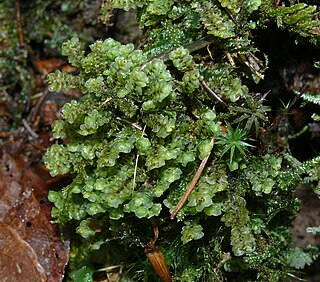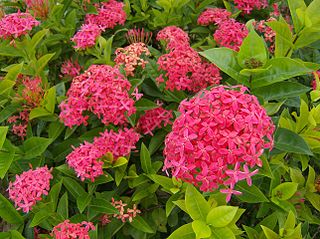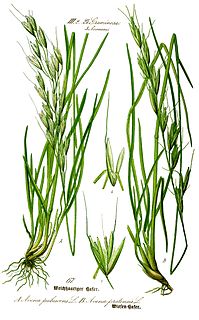Related Research Articles

Hydrangeaceae is a family of flowering plants in the order Cornales, with a wide distribution in Asia and North America, and locally in southeastern Europe. it comprises nine genera with 223 known species.

Juncus is a genus of monocotyledonous flowering plants, commonly known as rushes. It is the largest genus in the family Juncaceae, containing around 300 species.

Barthélemy Charles Joseph Dumortier was a Belgian who conducted a parallel career of botanist and Member of Parliament.

Menyanthaceae is a family of aquatic and wetland plants in the order Asterales. There are approximately 60-70 species in six genera distributed worldwide. The simple or compound leaves arise alternately from a creeping rhizome. In the submersed aquatic genus Nymphoides, leaves are floating and support a lax, umbellate or racemose inflorescence. In other genera the inflorescence is erect and consists of one to many flowers. The sympetalous, insect-pollinated flowers are five-parted and either yellow or white. The petals are ciliate or adorned with lateral wings. Fruit type is a capsule.

Scapania is a genus of plant in Scapaniaceae, a family of liverworts. It contains the following species :

Vulpia is a widespread genus of plants in the grass family, native to many countries around the world and naturalized in many of the nations to which it is not native. It is most common in temperate regions.

Kickxia is a genus of plants in the Plantaginaceae. It includes several species of plants known commonly as cancerworts or fluellins. They are mostly native to Europe, but two species, K. elatine and K. spuria are well-known elsewhere as invasive weeds.

Limbarda is a genus of succulent, xerophytic plants in the daisy family.
The APG III system of flowering plant classification is the third version of a modern, mostly molecular-based, system of plant taxonomy being developed by the Angiosperm Phylogeny Group (APG). Published in 2009, it was superseded in 2016 by a further revision, the APG IV system.

Stellaria pallida, commonly known as lesser chickweed, is an annual herbaceous plant in the flowering plant family Caryophyllaceae. It is native to Europe and is an introduced species in North America.

Ixoroideae is a subfamily of flowering plants in the family Rubiaceae and contains about 4000 species in 27 tribes.

Musschia is a genus of plants in the family Campanulaceae. It contains three known species, all endemic to the Madeira Archipelago in the eastern North Atlantic, part of the Republic of Portugal.

Avenula is a genus of Eurasian flowering plants in the grass family. Over 100 names have been proposed for species, subspecies, varieties, and other infraspecific taxa within Avenula, but only one species is accepted. The others names are all regarded as synonyms of other accepted names. The only recognized species in the genus is Avenula pubescens, commonly known as downy oat-grass or downy alpine oatgrass, native to Europe and Asia from Iceland and Portugal to Xinjiang, Mongolia, and Siberia. It is also naturalized in scattered locations in North America, in states as Connecticut, Delaware, Minnesota, New Jersey and Vermont, and in Canadian provinces such as Alberta, Manitoba, Ontario, Quebec, and Saskatchewan.
The APG IV system of flowering plant classification is the fourth version of a modern, mostly molecular-based, system of plant taxonomy for flowering plants (angiosperms) being developed by the Angiosperm Phylogeny Group (APG). It was published in 2016, seven years after its predecessor the APG III system was published in 2009, and 18 years after the first APG system was published in 1998. In 2009, a linear arrangement of the system was published separately; the APG IV paper includes such an arrangement, cross-referenced to the 2009 one.

Polygonoideae is a subfamily of plants in the family Polygonaceae. It includes a number of plants that can be highly invasive, such as Japanese knotweed, Reynoutria japonica, and its hybrid with R. sachalinensis, R. × bohemica. Boundaries between the genera placed in the subfamily and their relationships have long been problematic, but a series of molecular phylogenetic studies have clarified some of them, resulting in the division of the subfamily into seven tribes.
The Pteridophyte Phylogeny Group, or PPG, is an informal international group of systematic botanists who collaborate to establish a consensus on the classification of pteridophytes that reflects knowledge about plant relationships discovered through phylogenetic studies. In 2016, the group published a classification for extant pteridophytes, termed "PPG I". The paper had 94 authors.

Fossombronia is a genus of liverworts belonging to the family Fossombroniaceae.
Cephalozia is a genus of liverworts belonging to the family Cephaloziaceae.
Lophozia is a genus of mosses belonging to the family Jungermanniaceae.
References
- 1 2 3 4 "Blepharostoma (Dumort.) Dumort". www.gbif.org. Retrieved 18 February 2021.